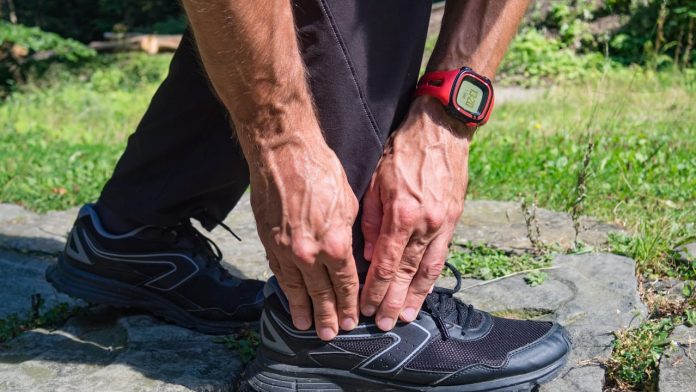Unlike an ankle fusion, which limit a patient’s mobility, ankle replacements offer patients vastly improved function of their ankle, with pain-free weight bearing and range of motion. To gain insight into the procedure, I consulted with podiatrist Dr. Justin Franson, whose practice is located in Valencia, California just north of Los Angeles. He is affiliated with the University Foot & Ankle Institute and specializes in ankle replacements using the latest ankle replacement technology available: INBONE. I also spoke with his patient, Marylynn, a Moorpark California resident who had her mobility restored with the procedure.
Dr. Franson notes that in the United States alone, approximately two million individuals annually visit their physicians for ankle pain as a result of arthritis or post-traumatic injuries. In addition, 50,000 of those people are diagnosed with end-stage ankle arthritis, a condition in which there is no cartilage left, resulting in bone-to-bone contact. This is a painful, common condition, and until recently, the only surgical option was an ankle fusion.
Dr. Franson noted that ankle replacement procedures were introduced 30 to 40 years ago; however, the low success rate (30 to 40%) resulted in loss of interest for the procedure. In the last decade, the procedure has enjoyed a resurgence, primarily due to improvements in the replacement joint. He notes that the INBONE Total Ankle Replacement (Wright Medical) is a vast improvement over previous devices. In the past five years, the success rate is about 85-90%. Dr. Franson notes that not everyone is a candidate for the procedure, such as obese individuals and those who place significant stress on their ankle on a regular basis. He also notes that, since the INBONE device only became available in 2005, long-term studies on its durability are lacking.
The procedure is commonly accepted in a number of cities, including San Francisco, Tucson, and Seattle. At present, however, the procedure has not gained wide acceptance in the Los Angeles area. Dr. Franson is passionate about the procedure and devotes time to educating the public in its regard. He notes that about half the procedures are performed by podiatrists and the other half by orthopedic surgeons. He admits that several decades ago, podiatrists were deemed to be less qualified than orthopedic surgeons because podiatric training was not standardized; thus, less-qualified practitioners were performing surgical procedures. That has all changed. Currently, a podiatrist must attend a podiatric medical school for postgraduate training, followed by a three-year residency. Inasmuch as the training focuses on the foot and ankle, the training for that portion of the anatomy is intensive.
Marylynn is a 60-year-old retired elementary school teacher who spent endless hours on her feet for more than 26 years. The wear and tear on her joints associated with her job and busy lifestyle led to severe osteoarthritis in her left ankle. In fact, the pain became so bad that as soon as the last student left her classroom, she immediately had to rest her foot on the desk to alleviate some of the pressure. Eight years ago when the pain began, she started to notice simple, mundane tasks, such as walking her dog to the mailbox, were progressively becoming more difficult.
Currently, Marylynn is an avid traveler; together with her husband and, on occasion, a few friends, she has traveled the world. However, her ankle problem impacted her enjoyment of exploring different cultures and places and made travel more difficult. As the pain became almost unbearable, Marylynn visited her podiatrist to discuss options and was told that the only curative method was an ankle fusion. Marilynn had some concerns. She researched the procedure and discussed it with patients that had undergone a fusion. Thus, she was well-apprised of the significant restriction in flexibility, which was not compatible with her lifestyle; thus, she chose to endure the pain.
In early 2013, the situation became intolerable; even standing up from the living room couch had become a chore. She threw in the towel and returned to her podiatrist; she was receptive to any surgical procedure that would relieve the pain, including a fusion. On this visit, however, her podiatrist described a new type of ankle replacement procedure and recommended a consultation with Dr. Franson.
After reviewing her MRI and x-rays, Dr. Franson determined that Marylynn was an ideal candidate for the INBONE procedure and ordered a CT scan. The results of the CT scan were then sent to Wright Medical to create her custom-made INBONE implant. After discussing the procedure with Dr. Franson and conducting some research, Marylynn scheduled the surgery, which would take place following a trip to Europe that began a week later.
On September 20, 2013, one month after she returned from Europe, Marylynn underwent the INBONE procedure. Three weeks after the surgery, she graduated to a non-walking boot and another three weeks later, began physical therapy. Marylynn completed physical therapy eight weeks later and was able to walk assistance-free.
In January 2014, Marylynn walked up 272 steps to the Batu Caves in Malaysia and traversed freely around Hong Kong, Vietnam, and Singapore. One month later, she was snorkeling and walking on the beach at her second home in Maui with no discomfort. “My new ankle gave me my life back,” said Marylynn. She added, “Before, I cringed at the thought of getting out of the ocean or standing up from a chair. Now, I’m back to traveling, going to the gym and walking my dog.”








